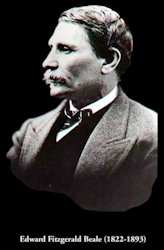- Honoring Carl Fabergé (d. 1920) and Tatiana Fabergé (d. 2020)
- The Impassioned Collector: Arthur E. Bradshaw (1879-1939)
- Harry Woolf, An Exceptional Man
- Gathering of Fabergé Enthusiasts in New York City
- Digital Colorization of Imperial Photographs: A Case Study of Time-Line Inconsistencies
- Discovering the World of Fabergé Furniture
Morte d’Arthur, Alfredt, Lord Tennyson, Written in 1845

POSTPONED!
- Biographical details in Wikipedia
- Tribute from her former employer, the European Organization for Nuclear Research (CERN) by Marie-Noëlle Fontaine, Nanie Perrin and John Ellis.
“Tatiana Fabergé (1930–2020): A Pillar of Theoretical Physics at CERN for Decades”, March 4, 2020. (Shared by Annemiek Wintraecken) - Andrew, John, Fabergé Heritage Council. “Tatiana Fabergé: An Outstanding Fabergé Scholar”, February 17, 2020.
- Skurlov, Valentin, Scientific Secretary of the Fabergé Memorial Fund. “Long Live the Name of Fabergé”, Russian Newspaper Vedomosti, February 17, 2020. (Shared by the author, translated by Riana Benko)
The most important brainchild of Tatyana Feodorovna was her grandfather’s Fabergé Memorial Fund which she created in 1996, the year of the 150th anniversary of the birth of the great Russian jeweler. In the same year, Tatyana Fabergé took the part in the unveiling of a monument to Carl Fabergé in St. Petersburg on the unnamed square near the metro station Ladozhskaya. After two years, the square received the name of Carl Fabergé. Now the fund has more than 720 members from 22 countries of the world.
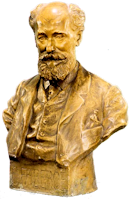
1903 Plaster Bust of Carl Fabergé
by Joseph Limburg (1874-1955)
(Tatiana Fabergé Family
Archives, Geneva)

In 1996, Sculptor V.V. Ivanov, Tatiana F. Fabergé, and Valentin Skurlov
examining the sculpture based on the original 1903 bust.
(Fabergé, Tatiana F., Kohler, Eric-Alain, and Valentin V.
Skurlov. Fabergé: A Comprehensive Reference Book, 2012, p. 11)

The sculpture stands on
Fabergé Square in front of
Russkiye Samotsvety (“Russian
Gems” Jewelry Business)
which supported the project.
Tatyana Feodorovna sincerely loved St. Petersburg and always eagerly visited the city, where her father Feodor Agafonovich was born in 1904 [died 1971]. He was the only grandson of Carl Fabergé who took up the profession of a jeweler. She helped her father, because she was a designer, and she willingly made contact with reporters. Tatyana Feodorovna loved to travel and talked about the famous Fabergé firm in various countries of the world.
She was the co-author of ‘17’ books on the history of the Fabergé firm and was a welcome guest at jewelry exhibitions and conferences dedicated to the work of her great-grandfather.
Her dream was to return the name of Fabergé to Russia. As a result, we have the Fabergé Museum in St. Petersburg and Fabergé exhibition halls in the Hermitage Museum. She was a true part of the St. Petersburg culture, with a broad Russian soul, and kept the Orthodox faith. Peace be upon her.”

Arthur E. Bradshaw with Six Dachshunds
(Family Photograph Album with Kind Permission of Harry Bradshaw)
None of this kept AEB busy. He inherited a small 28-acre estate called The Grange on the death of his father in 1899. He was 20 and had no experience of running such a place, having spent his life up until that moment either at boarding school or in the Navy. He came home to a farm with a herd of Jersey cattle and a dairy, an eccentric, crenelated house, a huge garden, several cottages, a staff – at full strength – of 18, a widowed mother, and an unmarried sister. Having been honorably discharged from the Navy on account of his weak lungs, he chose to spend up to six months of the year away from England, and regularly traveled to the warmer climes of south Africa where he had many friends and passed his time playing golf and cricket. In 1914, he married his mother’s companion, Evelyn Phillips, and settled down to run his estate. Three generations of Bradshaw’s lived at The Grange; they were the squires of Steeple Aston and to this day are highly regarded in the village.

Balalaika Player by Fabergé
(Postcard Victoria and Albert Museum,
McCanless Collection; Christie’s Geneva,
November 18, 1980, Josianne Woolf
Collection, Part I, Lot 141)

Fabergé Lilies of the Valley Basket
(Courtesy Gray Collection and
Metropolitan Museum of Art)

Holmström Cigarette Case with an Imperial Eagle and an
Inscription on the Interior of the Lid, “To Arthur E. Bradshaw,
a man who radiates happiness and charm,
Emanuel Snowman, 1935”.
(Keefe, John. Masterpieces of Fabergé: The Matilda
Geddings Gray Foundation, 1993, pp. 68-69)
AEB returned to Wartski the following week (third week in February 1935) and bought a Fabergé box he had seen on his first visit. By the time of the famous Russian exhibition in June of 1935 at No. 1 Belgrave Square, London, AEB had acquired 18 objects which he was persuaded to lend. By the end of the year, he had spent over £7,000, and Emanuel Snowman, had become a friend and presented him with an engraved, lilac guilloché enameled cigarette case by Fabergé (above). The case is exhibited at the Metropolitan Museum in New York City through November 2021 as a loan from the Matilda Geddings Gray Collection in New Orleans, together with the exquisite Lilies of the Valley Basket which Fabergé scholar Géza von Habsburg calls “an immortal work of art”.
But AEB was not behaving like an ordinary collector. While his dogs were much photographed, and the cars were highly visible and also photographed with the chauffeur and dogs in attendance, he was positively secretive about his objets d’art. Displayed in glass-fronted cases in the dining room of The Grange, there is only one, slightly-blurred photo of one of the cases containing a few recognizable objects. Nobody in the village knew anything about this treasure trove and he did not show it off. I imagine, for him collecting was about the thrill of the chase, and he kept buying at a pace that dismayed his wife, who feared his extravagance would lead them into bankruptcy. After his death, Evelyn sent all but four pieces of table silver back to Wartski for resale. The important pieces ultimately made their way into the collections of the English Royal Family, well-known collections in the USA, and the Fabergé Museum in St. Petersburg, Russia. When Evelyn died in 1950, the last of the Fabergé silver was sent to auction where the most elaborate, a silver gilt kovsh crowned with Imperial eagles, was purchased by Prince V. Galitzine for the princely sum of £205 (Sotheby’s London, July 13, 1950, Lot 93). Nothing remains in the family today apart from remnants of jewelry, but occasionally something crops up. A few years ago, a person living in the now sub-divided house of The Grange dug up a jade rabbit in the garden. The expert opinion was that given the provenance the object was “more than likely Fabergé,” but alas, the rabbit was missing an ear and, as perfect condition is everything, it was virtually worthless.
What was astonishing about the Bradshaw Collection is not only the number of objects, but the apparent discernment Arthur showed in his purchases. But there were bound to be a few misses, and indeed there were. The inventory included three undoubtedly fake objects: the infamous Nicholas II Equestrian Egg, and two other pieces also labeled “Tercentenary”, a thermometer and a kovsh, both marked Fabergé. The hunt for the whereabouts of the fake egg occupied me for the best part of a year, and of course there is much, much more to AEB’s story. In a book. Soon to be published.
1 June 8, 1935. Sold to Arthur E. Bradshaw, London, for £1,900; sold back to Wartski after Bradshaw’s death, 1939.
McCanless, Christel Ludewig. Fabergé & His Works: An Annotated Bibliography of the First Century of His Art, Scarecrow Press, 1994.
McCarthy, Kieran. Fabergé in London. The British Branch of the Imperial Russian Goldsmith, ACC Art Books, 2017.
Munn, Geoffrey. Wartski, The First One Hundred and Fifty Years, Antique Collectors’ Club, 2015, pp. 236-240.
von Habsburg, Géza. Fabergé Fantasies and Treasures, Universe Publishing, 1995, pp. 58-59, 79-80.

Harry Woolf on The Sea Cloud, Italy, Sept 2009
(Courtesy of the Woolf Family)
Harry’s interests were diverse, but this was a reflection of his intellect and energy. One of the areas of keen focus were the arts and he is recognized as one of the more significant collectors of Russian art. But “why Fabergé?” I once asked Harry this question. He told me that he was resolute not to be like his father who in the early 1960’s, at seventy, was sitting and watching a pretty poor show on television. He was determined then and there to find a “suitable hobby such that my mind could be occupied, at least a little, at a similar age”. He conversed with a number of London dealers, who dealt in items from early clocks to contemporary art; none hit the mark nor sparked a serious interest. It happened at a dinner in London when a friend showed him a small Fabergé silver model of a samovar which he offered to Harry at cost. He read a book on Fabergé and met the author, Kenneth Snowman. Learning Carl Fabergé was from Russia, the birth place of Harry’s paternal grandparents, he decided Fabergé should be his focus. He embarked on the mission with passion.
I had the privilege of meeting Harry almost 40 years ago, when I was in my early twenties and setting forth as the numero due in the newly established Russian Department at Christie’s in New York. It was during the sophisticated Fabergé auctions held bi-annually at the Hotel Le Richemond in Geneva. I could sense immediately Mr. Woolf was a natural collector with a most-attuned eye, taste and charm in spades. Although most found him somewhat daunting, I approached him with all the brashness of youth which proved to be the beginning of a fulfilling friendship which expanded to encompass his family over the years. They were always of major importance in his life. Harry was a most generous man, possessing a great sense of humor, always available and as I learned, a great connoisseur of fine wines.

Exhibition Catalog in Aid of
Samaritans (May 15-20, 2012) at
Wartski London featuring the
collection of Harry Woolf, who in
the foreword tells how he began
his collection, and Geoffrey
Munn in an introduction reflects
on Mr. Woolf’s connoisseurship
as a collector of Fabergé objects.


Silver-gilt cream jug, and silver-gilt and enameled frame with a portrait
of Cléo de Mérode, both objects made in the Moscow shops in the 1890’s.
(Carl Fabergé – A Private Collection, 2012, pp. 3, 5, 27, 46-47)
Having been directly involved in the original sale, I know one of his biggest regrets was not becoming the owner of the magnificent 1913 Winter Egg. Some months later he had a second opportunity to acquire the Winter Egg at an auction in Geneva but through an unexpected bidding issue, he missed the moment. Nonetheless, what he created was without equal and remains as one of the most iconic Fabergé collections. His courage was remarkable as his health failed and I believe he never complained even at the end. A week before he died Harry requested to see some objects included in the London sales and even added a few to his collection. It would probably have amused Harry to know he died a month short of 2020 which would be the 100th anniversary of Carl Fabergé’s passing. As another passionate American Fabergé collector wrote upon hearing the news: “It is truly a loss in the Fabergé community with the passing of HW. Clearly, a man of means, who loved the chase, as much as the acquisition!” Our thoughts are with his wife, Josiane, who was not just his loving wife but partner in every way, and also his family.

A La Vielle Russie (New York)
Thank you for the Complimentary Tickets!
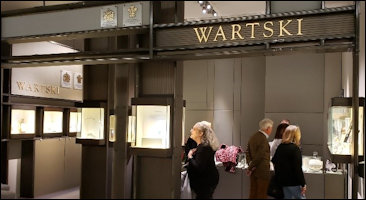
Wartski (London) Façade Modeled after the
Original Store on Grafton Street

Fabergé Brunch Hosted by Jim Hurtt

Hand-made Egyptian Pendant Commemorating
the “Fabergé Marathon”
The Imperial court retained professional photographers such as ‘Boisson and Eggler – Photographers of Their Imperial Majesties’. In 1902, Swiss photographer Fréderique Boisson [Фредерик Буассон], and his German colleague Fritz Eggler purchased the studio of the famous court photographer ‘Pasetti’ in St. Petersburg. These gentlemen became the favored photographers. Among the first to do sittings in the homes of their clients, Eggler himself was known as a master of the refined portrait and employed artistic poses, and enhanced lighting. Some 914 such photographs were taken by the firm at the Alexander Palace in Tsarskoye Selo.
Personal photography surged in popularity when in 1888 Kodak introduced its Box camera, capable of capturing 100 exposed images. Families, including the royalty of Europe and Russia, began recording their own impromptu events, and hence personal photo albums were kept and are extant today.

Maria, Olga, Tatiana, and Anastasia with Kodak Box Camera
on the Imperial Yacht Standart, 1912
(ГА РФ, ф. 651 оп. 1 д. 261)2
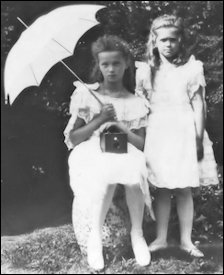
Olga and Maria with Kodak
Brownie in Peterhof, 1907
(ГА РФ, ф. 673. оп. 1 д. 196 л. 16)
Predating the advent of color photography, Fabergé engaged the notable miniaturist painter Vasili Zuiev (1870-1941)3, whose miniatures appear on the 1911 15th Anniversary Egg, 1908 Alexander Palace Egg, and the 1903 Peter the Great Egg.4

1910 – Maria Nikolaevna in a
1910 Sitting
(Bokhanov, A.N., Editor, et al.
The Romanovs: Love, Power
& Tragedy, 1993, p. 126)
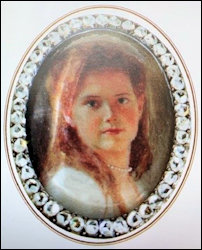

Miniature by Vasili Zuiev on the 1911 15th Anniversary Egg
(Muntyan, Tatyana. Fabergé Masterpieces from the Collection
of the Link of Times Foundation, 2016, pp. 148)
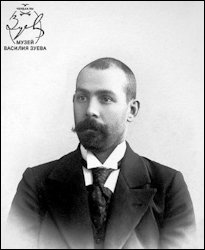
Photograph of Vasili Zuiev Shared by
Valentin Skurlov, Russian Scholar, in
Memory of the Miniaturist born on this
day, (March 31, 2020) 150 years ago.
Where were we? Oh, yes, Time Travel. Chaos theorist, James Gleick writes: “Is the future already contained in the past? … Changing the direction of time is as easy as changing a sign from plus to minus.”6


1904 Fabergé-style Egg from the Exhibition Entitled,
Fabergé Style: Excellence Beyond Time, December 15, 2018 – March 24, 2019
(Museum and Exhibition Complex, New Jerusalem near Moscow, Russia)
- Photographs are taken during a sitting at a specific time in history. An artist working at Imperial behest, paints a miniature ‘after’ the photograph, or he may also have hand-colored an original, depending on the nature of the request. Illustrations from original sittings and original miniatures from Imperial Fabergé Easter eggs have been compiled below for the four daughters of Emperor Nicholas II and his wife, Alexandra, and the Imperial pair. Column 1.
- Software graphics technology initiates ‘colorization’ of archival photographs. DeviantArt formed in 2000 is an online community featuring artwork, videography, and photography using these techniques. Column 2.7
- From the year 2000 on, ‘miniatures’ painted ‘after’ these digitally colorized photographs have appeared. Examples in column 3 are based on a 1904 Fabergé-style egg.
Links, where possible, and commentary along with a system of arrows designates the ‘direction of Time’ for the photographic collage:
 suggests the dates move in the accepted forward direction.
suggests the dates move in the accepted forward direction. suggests the dates move out of historical context and backward in time.
suggests the dates move out of historical context and backward in time.
| Column 1 Archival Photograph | Column 2 Colorized Photograph | Column 3 1904 Fabergé-style Egg |
|---|---|---|
 Olga Nikolaevna (1895-1918) | Internet link (see endnote 7 for existing reproduction limitations): Olga’s court dress, kokoshnik & tie bows are colored in pale pink, her ribbon of the Order of St. Catherine (awarded at baptism) is appropriately in red. On her shoulder is the correct blue ribbon holding her father’s 1896 coronation medal. |  |
| 1904 - Archival photograph taken by Boisson & Egglers, Photographers of Their Imperial Majesties.8 (Wikimedia Commons) | The colors in the miniature are reproduced in detail from the colorized version. | |
 Tatiana Nicholaevna (1897-1918) |  Internet link: In the colorized version, the details of Tatiana’s traditionally white dress, shoulder bows and cummerbund are depicted in blue. |  |
| 1906 - Archival photograph was taken at a formal sitting.9 (Wikimedia Commons) | The miniature portrait of Tatiana is here depicted in blue, however, the original photograph used for this ‘1904 Fabergé-style egg’ was not taken until 1906. | |
 Maria Nikolaevna (1899-1918) |  The colorized photograph in ‘blue’ is no longer shown on the Internet at press time. |  |
| Photograph from a 1910 Sitting10 (Bokhanov, A.N., Editor, et al. The Romanovs: Love, Power & Tragedy, 1993, p. 126) | Maria’s dress is tinted blue on the missing colorized 1910 photograph. The accent binding at the neck and upper arms appeared in a contrasting ivory tone on the missing colorization and shown here on the ‘1904 Fabergé-style egg’. | |
 Anastasia Nicholaevna (1901-1918) |  Internet link: Various color schemes of this original photograph can be found in green, pink, etc. In this version, her shoulder bows and cummerbund are colored in pink corresponding to the details of the image of Anastasia shown in the ‘1904 Fabergé-Style’ egg to the right. |  |
| 1906 - Archival photograph in the same formal sitting as her sister Tatiana.11 (Boisson & Egglers - GARF) | The ‘1904 Fabergé-style egg’ is dated two years before the original 1906 photograph. |
A photograph of Anastasia from the same 1906 sitting as above shows her familiar puckish smile. Vasili Zuiev used his original photograph for his miniature on the 1908 Alexander Palace Egg.

CLICK THE ABOVE PICTURE
FOR A LARGER VIEW
Photograph incorrectly dated
to 1911 when she would
have been 10 years old
(Muntyan, Tatyana. Fabergé
Masterpieces from the
Collection of The Link of
Times Foundation,
2016, p. 158)

Zuiev Miniature and 1908 Imperial Egg by Fabergé
(Skurlov, Valentin. Vaslii Zuev: pridvornyi miniatiurist, khudozhnik firmy Faberzhe
[Vasiii Zuev: Court Painter of Miniatures, Artists in the Fabergé Firm], 2017, p. 93; Wikimedia)
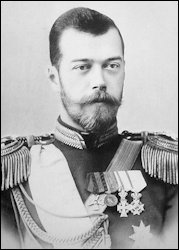
A. 1894 Cabinet Card (CdV)
(Courtesy Daniel Brière Collection)

B. 1895 Chromolithograph
(Courtesy Daniel Brière Collection)

C. 1900 Oil on Canvas, Nicholas II
by Ernst Fredrich von Liphart,
Russian Painter (1847-1932)
(Wikipedia)
The 1894 Cabinet Card (CdV)12 image (A.) in sepia tone and the chromolithograph (B.) depict Nicholas II with a 4-medal bar (kolodka) on his dress uniform, while the last illustration (C.) depicts his 5-medal bar:
- Order of St. Vladimir (4th class, awarded in 1890)
- Medal for Alexander III Coronation (established May 12, 1883)
- Cross of Honor (“Silver Cross”) of the Danish Order of the Dannebrog (awarded Sept. 11, 1891)
- Greek Order of the Redeemer (awarded May 6, 1884). Medal 3 and 4 were awarded to Nicholas since both the Danish and Greek Royal Houses were familial connections.
- Medal for the Reign of Alexander III (was established by Imperial decree on February 26, 1896)

1902 Cardinal Rampolla13 Presentation Snuff Box with the
Miniature of Nicholas II with a 5-Medal bar by Alexander
Petrovich Blaznov (1865-1939), a miniaturist usually specializing
in ecclesiastical subjects, worked for Fabergé.
(Skurlov, Valentin. Vaslii Zuev: pridvornyi miniatiurist,
khudozhnik firmy Faberzhe [Vasiii Zuev: Court Painter
of Miniatures, Artists in the Fabergé Firm], 2017, p. 87)
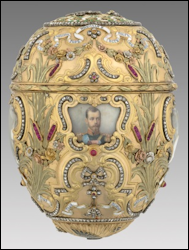
1903 Peter the Great Egg with the signed
Zuiev Miniature by Fabergé (Virginia
Museum of Fine Arts, Bequest of
Lillian Pratt, Photo: Katherine Wetzel
© Virginia Museum of Fine Arts);
(Fabergé Research Newsletter,
Spring 2016 – 10th Anniversary Edition)
| Column 1 Miniature from the 1903 Peter the Great Egg | Column 2 Colorized Photograph | Column 3 1904 Fabergé-style Egg |
|---|---|---|
 |  The arrow of Time goes in the wrong directions for the medals on the ‘1904 Fabergé-Style’ egg. |  |
| Miniature of Emperor Nicholas II, signed on left, В. Зуевь [court miniaturist, Vassilii Ivanovich Zuiev (1870-after 1931)] watercolor, ivory on the 1903 Peter the Great Egg (above) portrays the Emperor wearing a 5-medal bar. It appears to be ‘after’ the 1902 Blaznov miniature. (Virginia Museum of Fine Arts, Bequest of Lillian Pratt, Photo: Travis Fullerton © Virginia Museum of Fine Arts) | The arrow of Time appears to change directions in that the Emperor once again wears a 4-medal bar which depicts him in the December 1892 - Spring 1896 time frame. The artist of the 1904 miniature has miscolored the ribbon of the Cross of Honor (“Silver Cross”) of the Danish Order of the Dannebrog in blue, when it should be the traditional red & white of the Dannebrog and the Danish Flag. The ‘Danish Cloth’, the oldest continuous national flag, was in use since the 14th century. |
My observations are that none of the miniatures on the ‘1904 Fabergé-Style’ egg in this case study are up to the artistic standards of Vasili Zuiev, the Russian court miniaturist, and in particular, the ‘1904’ miniatures of the Emperor and Empress fall dreadfully short. Distortions in facial shape, and the peculiar eye treatment are disturbing when one considers the abundance of images available for examination.
This essay reviews historical photographs used by both Carl Fabergé in the creation of certain of his Imperial Easter Eggs, and more recently miniatures created ‘after’ digital colorizations of these Imperial photographs without consideration for their historical context. Comparisons leave us with serious ‘time-line’ inconsistencies.
Perhaps the reference to the directional flow of Time from theoretical physicist, Richard Feynman (1918-1988), states the case best: “Well, you see that all there is to it is that the irreversibility is caused by the general accidents of life … Fifteen billiard balls could smash around a table and finally come to a stop in a perfect triangle they could, and the probability is not zero, but when you see that happen, you know that the film has been reversed.”14
So in the future the past decays,
Fearful festival of dead leaves.
Anna Akhmatova (1899-1966)15
1 The coronation of Nichols II was in 1896.
2 Courtesy of the State Archive of the Russian Federation (GARF).
3 Skurlov, Valentin, et al., Vasiii Zuiev: pridvornyi miniatiurist, khudozhnik firmy Faberzhe (Vasilii Zuiev: Court Painter of Miniatures, Artists in the Fabergé Firm), 2017. In Russian; an earlier publication is Vasilii Ivanovich Zuiev, Artist-miniaturist of the Fabergé Firm by Vasilyeva, N.I. and V.V. Skurlov, 2015, in Fabergé Research Newsletter, Winter 2015
4 For other Fabergé Imperial Easter eggs with Zuiev miniatures, see the Imperial Egg Chronology on the Fabergé Research Site.
5 Their nautical attire on the Imperial Yacht Standart is one exception.
6 Gleick, James. Time Travel: A History, 2016, pp. 131, 114.
7 Due to recent copyright restrictions (EU GDPR and California law), some of the colorized versions of these original photographs cannot be added to this study, because the web sites require time-consuming copyright permission requests, and/or charge fees for the use/purchase of modern colorized photographs. Social media illustrations change frequently, have not gone through the GDPR process, and are also not included.
8 This photographic image was not used as a model on an Imperial Egg by the original Fabergé firm.
9 This photographic image was not used as a model on an Imperial Egg by the original Fabergé firm.
10 This photographic image was not used as a model on an Imperial Egg by the original Fabergé firm.
11 This photographic image was not used as a model on an Imperial Egg by the original Fabergé firm.
12 This ‘carte de visit’ was a type of small photograph mounted on stiff pieces of cardboard was patented in Paris by photographer André Adolphe Eugène Diséri in 1854. These cards became a fixture in the late 19th century Victorian parlor. Often presented in ‘sepia tone’, a chemical process of changing the color of silver-based photographic prints.
13 On August 30, 1898, the Russian minister to the Holy See, Alexander Isvolsky, called on the Cardinal Secretary, Mariano Rampolla, with a communication from his government. A week earlier, Nicholas II proposed an international conference to consider ways to limit world armaments and secure a just and durable peace.
14 Gleick, James. Time Travel: A History, 2016, pp. 114-18.
15 Haight, Amanda, Anna Akhmatova: A Poetic Pilgrimage, 1976, p. 151. Anna Andreyevna Akhmatova (1899-1966), born Gorenko, was one of the most honored Russian poets. She was short-listed for the Nobel Prize in 1965.
- Mikhail Perkhin, head workmaster (М.П.), the most prolific maker of miniature furniture – a dozen or so – was replaced after his death in 1903 at age 43 by
- Henrik Wigström, senior workmaster (
 ) for whom only three pieces of miniature are known.
) for whom only three pieces of miniature are known. - Julius Alexander Rappoport, workmaster (active 1883-1908,
 ) gave his workshop to his employees, who formed the First St. Petersburg Silver Cooperative/Artel, it may have existed from 1908-11,
) gave his workshop to his employees, who formed the First St. Petersburg Silver Cooperative/Artel, it may have existed from 1908-11,  ).
). - Hjalmar Armfelt, workmaster (active 1904-1917,
 ), and
), and - Moscow Gold and Silver Factory (February 1887 – January 1918).2
Perkhin miniature furniture

Fabergé Miniature Bonbonnières – Louis XVI Style Table (A.) and French
Empire Style Chair (B.) Withdrawn at Auction!
(Sotheby’s London, June 4, 2019, Lots 257 and 256, frontispiece, title
page, pp. 34-413; Video entitled “The Secret Compartments of a Fabergé Riddle”)

Mikhail Perkhin (b. 1860 [o.s.] – 1903),
Fabergé’s Second Chief Workmaster
is Described as a “Phenomenal,
Prodigious Talent.”4
The miniature bonbonnière chair (B.) from the Mikhail Perkin studio was in the news before its 2007 auction.5 At the time, Fabergé authority Géza von Habsburg shared three major observations in the American and British press6 which still hold true 13 years later in 2020:
- “Fabergé furniture is extremely rare, which accounts for its enormous value, …
- smaller than the number of surviving Fabergé Easter eggs, which is 427…
- the estimate ($1 million-1.5 million), while staggering, is perfectly realistic.”
The chair, a mere 2 1/4″ tall, was sold in 2007 for $2.28 million (including the auction house commission) to an unnamed buyer after a fierce battle between two phone bidders. In 2019, the same chair and a miniature table (A.), each with a similar estimate of $1,060,000-1,590,000, were withdrawn from the auction.8
Height: 3 1/2″ (8.9 cm), ca. 1901. Workmaster’s initials Mikhail Perkhin (М.П.), Fabergé in Cyrillic, assay mark of St. Petersburg, 1896-1908, 56 standard, original fitted case, scratched stock number 6864. (Forbes, Christopher, and Robyn Tromeur-Brenner. Fabergé: The Forbes Collection, 1999, pp. 98-99; Sotheby’s London, 2019)
Provenance of the table (A.):
- von Solodkoff, Alexander. Russian Gold and Silver Work, 17th-19th Century, 1981, pp. 118 (illustration #135), 123. Bonbonnière is illustrated without a provenance or a photographic credit.
- Acquired by the Forbes Magazine Collection, New York, from Aux Menus Plaisirs, London, date unknown.
- From 1985-1999 the table was regularly included in Forbes publications and loan exhibitions.9 The last date coincides with publication of the catalogue raisonné for the Forbes Magazine Collection as the family began estate planning to turn over the Forbes business in an orderly fashion to the next generation10.
- Sotheby’s London, June 4, 2019, Lot 257, estimate: $1,060,000-1,590,000, object withdrawn before the auction.
Perkhin miniature bonbonnière chair (B.):
The publicity in print before and after the 2007 sale for the $2.28 million miniature bonbonnière chair was quite voluminous. In a contemporary article, “100 Top Treasures”, the best art objects sold or donated in 2007 were described with the chair chosen as #65 complete with a tongue-in cheek observation, “Considering its diminutive size (2 1/4” high), that translates to approximately $1 million per inch”.11 In a more serious vein, the antique jewelry dealer Wartski in London published a stunning brochure supplemented with a detailed website (now abbreviated) with new provenance research.
CLICK THE ABOVE PICTURES (CENTER GROUP IS ONE LARGE PICTURE) FOR LARGER VIEWS WITH TEXT AS THEY APPEARED IN THE BROCHURE
B. Brochure, Perkhin Miniature Bonbonnière Chair, Height 2 1/4″ (5.7 cm)
(Courtesy Wartski London)
Height: 2 1/4″ (5.7 cm), ca. 1898. Workmaster’s initials Mikhail Perkhin (М.П.), Fabergé in Cyrillic, 72 standard, scratched stock number 1920 (Sotheby’s New York, 2007, and Sotheby’s London, 2019)
Provenance of the chair (B.):12
- March 9-15 [o.s.], 1902, Charity Exhibition of Fabergé Artistic Objects, Old Miniatures and Snuff Boxes on view in the von Dervis Mansion in St. Petersburg, Russia, includes objects from the Imperial Family’s Fabergé collection. The Perkhin chair is clearly visible in an archival photograph of Maria Pavlovna’s display case (C.) in the venue.



C. Gold Drawing Room, 1902 von Dervis Exhibition with Maria Pavlovna Display Case and Close-up of the Miniature Chair

D. Miniature Chair (B.) Prototypes. Chair on the far right
as seen in Pein, Georg. Design for Two Chairs,
1809, resembles the chair discussed in this essay.
(Illustrations Courtesy Sotheby’s London,
June 4, 2019, pp. 36-37)

E. Translated Advertisement for the 1902 von Dervis Exhibition
(Fabergé, Tatiana, Proler, Lynette G. and Valentin V. Skurlov. The Fabergé Imperial Easter Eggs, 1997, pp. 52-57).

F. Original Photographs from the von Dervis exhibition by the Russian
Photographer Karl Bulla (1853-1929) are shown on the Fabergé Eggs website
maintained by Annemiek Wintraecken.

G. Original vitrines still in
use at the Hermitage
Museum are discussed in
1902 von Derwies
Exhibition Vitrines and Their
Historical Connections
Fabergé Research
Newsletter, Spring
and Summer 2017.
- Emperor Nicholas ll writes in his journal about the exhibition on March 9, 1902:
“… After breakfast we went to see the opening ceremony of Alix’s charity fete in Dervise’s house. It felt strange to see my own things as well as the things belonging to other people whom I knew very well. The collections of the old snuff-boxes and miniatures were very interesting …” (Fund 601, doc. 237. January – September 1897 [sic]13, translated by Jsenya Dyakova)
- October 30, 1917, five days after the October Revolution, a jewelry inventory collection belonging to Grand Duchess Maria Pavlovna (1854-1920), wife of Grand Duke Vladimir Alexandrovich of Russia, records the miniature bonbonnière chair as item 466. Her passion in jewels is confirmed in the inventory listing (H.) which contains 1559 Fabergé objects, packed in 21 boxes, most likely inventoried by Agathon Fabergé, Carl Fabergé’s second son, a 2014 publication entitled, Grand Duchess Maria Pavlovna (I.), and in her Wikipedia entry.

H. ФОНД Kонтора двора вел. кн. Bладимира
Aлександровича и вел. кн. Mарии
Павловны (Grand Duchess) ДЕЛО № – Общие
вещц находитца во дворцe.
(FOND of the Official Court, Grand Duke
Vladimir Alexandrovich and Grand
Duchess Maria Pavlovna BUSINESS (CASE)
No. – General Objects from the Palace)
(Courtesy Wartski London)

I. Monograph profusely illustrated
with over 300 photographs by independent
Russian scholars, Galina Korneva and
Tatiana Cheboksarova, who have studied
the life and times of the Grand Duchess
and her family for more than 20 years.14
Entries from the 1917 Maria Pavlovna inventory:

465. Bonbonnière – Golden Armchair – Fabergé Works. In 2020: Object not yet found! (Sotheby’s London, 2019)


J. Folio Entry
(Courtesy Wartski London)

K. Enameled Fabergé Miniature
Bonbonière Chair, Mikhail Perkhin, ca. 1898
(Wigmore, Barry, “Miniature Chair with £1m
Price Tag“, Daily Mail, April 19, 2007)
Also listed in the Maria Pavlovna inventory is a Fabergé miniature bonbonnière table, possibly similar to the object in (A.) above:

Box 8
Bonbonnière – Table, Agate in Gold Rim and Rock Crystal on the Top, Fabergé Works. (Sotheby’s London, 2019)
In 2020: Object not yet found!
(Ed. Note: This entry is misidentified on page 40 of the auction catalog as Number 559.)
- The Ratibor Family, Princes of Ratibor and Corvey. In 2017, identified as Property of a European Princely Family.
- With Wartski.
- Sotheby’s London, June 4, 2019, Lot 256, estimate US $ 1,060,000-1,590,000, withdrawn before the sale. Lots 256-267 include three essays – Furniture of Fantasy, Fabergé Miniature Furniture: Style and Technique, and Sources for the Design15 for additional fascinating background information on Fabergé’s miniature furniture production.
Wigström miniature furniture
A bonbonnière and two salt cellars from the studio of Wigström, Fabergé’s senior workmaster (![]() ) who took over Perkhin’s workshop after his death in 1903, are now permanently on display at the Fabergé Museum in St. Petersburg, Russia, and the Cleveland Museum of Art in Ohio, USA.
) who took over Perkhin’s workshop after his death in 1903, are now permanently on display at the Fabergé Museum in St. Petersburg, Russia, and the Cleveland Museum of Art in Ohio, USA.

Henrik Wigström (1862-1923)
(Courtesy Tillander-Godenhielm Image Archives16)

L. Wigström Fabergé Miniature
Bonbonnière Chair – Empire Style,
Height 2 7/8″ (7.4 cm)
(Photograph Riana Benko)


M. Bonbonière Chair with Wigström Sketches
(Tillander-Godenhielm, Ulla, et al. Golden Years of Fabergé: Drawings and Objects from the Wigström Workshop, 2000, pp. 102-103)




N. Various Positions of the Hinged Sliding Top. Fabergé Marks are in the Fourth Photograph.
(Courtesy Fabergé Museum, St. Petersburg, Russia)
Height 2 7/8″ (7.4 cm) Marked with initials of workmaster Henrik Wigström ![]() , Fabergé in Roman letters, 72 standard (18 karat), and with initials C.F. together with London import marks for 1911. Original holly wood box. (Sotheby’s New York, December 15, 1989, Lot 367; Art and Antiques, Vol. 7, No. 3, March 1990, p. 73) Stock number 22841 (Forbes, Christopher, and Robyn Tromeur-Brenner. Fabergé: The Forbes Collection, 1999, pp. 98-99, 278).
, Fabergé in Roman letters, 72 standard (18 karat), and with initials C.F. together with London import marks for 1911. Original holly wood box. (Sotheby’s New York, December 15, 1989, Lot 367; Art and Antiques, Vol. 7, No. 3, March 1990, p. 73) Stock number 22841 (Forbes, Christopher, and Robyn Tromeur-Brenner. Fabergé: The Forbes Collection, 1999, pp. 98-99, 278).
- Stock number 22841 appears in an inventory – dated April 30, 1919 – of the Moscow Fabergé branch at 4 Kuznetskii Most. Confiscated by the Soviets, the object is identified as a “bonbonnière ashtray (sic) costing 6,500 rubles”.17 How a Fabergé object with a London import mark for 1911 appears in Russia in 1919 remains a mystery. It is known, however that
“Fabergé was forced to close all of his premises after the Russian Revolution of 1917. His last sale in London was recorded on 9th January, 1917. Shortly after this entry, the shop on Bond Street was closed. The remaining stock was acquired by the French jeweler Lacloche Frères, who relined the holly wood cases with their own lid satin and sold the pieces from their shop at 2 New Bond Street in London.”18
- Sotheby’s New York, December 15, 1989, Lot 367 Estimate $100,000-150,000, sold to the Forbes Magazine Collection for $220,000 including a 10% buyers’ premium.19 Anonymous sale with A La Vieille Russie as the agent.
- 2004 Sold privately to The Link of Times Collection and now exhibited20 in the Gold Room of the Fabergé Museum, St. Petersburg, Russia.
Two salt cellars by Henrik Wigström have been a part of the permanent collection at the Cleveland Museum of Art since the mid-1960’s.

Salt Chairs (left and right)
To be continued in another issue of the Fabergé Research Newsletter.
1 Miniature sedan chairs are not included.
2 Biographical reference resources for Fabergé workmasters: Lowes, Will, and Christel Ludewig McCanless. Fabergé Eggs: A Retrospective Encyclopedia, 2001, pp. 175-245; Tillander-Godenhielm, Ulla. Fabergé: His Masters and Artisans, 2018.
3 Details no longer on the Internet.
4 Tillander-Godenhielm, Ulla. Fabergé: His Masters and Artisans, 2018, pp. 70-85.
5 Sotheby’s New York, April 16, 2007, Lot 32, pp. 36-37.
6 Moonan, Wendy, “Definitely Imperial But Way Too Tiny for Napoleon”, New York Times, April 13, 2007, Section E, PT2, Column 1, p. 37; Wigmore, Barry, “Take a Seat … for Pounds 1m; But Don’t Try Putting Your Feet Up, It’s Only Two Inches High”, Daily Mail (London), April 20, 2007, First Edition A, p. 34.
7 Third Imperial Egg found in 2014 changes the new total to 43 extant eggs out of the 50 made by the original Fabergé firm which closed in 1918.
8 Sotheby’s London, June 4, 2019, Lot 256 (B. Chair) and 257 (A. Table).
9 Forbes, Christopher, and Robyn Tromeur-Brenner. Fabergé: The Forbes Collection, 1999, p. 278.
10 Scherer, Barrymore Laurence, “Imperialcoup”, Art & Auction, April 2004, pp. 65-68.
11 Art & Antiques, November 2007, p. 87.
12 Based on Sotheby’s New York, April 16, 2007, Lot 32; Sotheby’s London, June 4, 2019, Lot 256; Wartski Research.
13 Date (1897) of the Fund citation appears to pre-date by five years the Emperor’s diary citation and the date of the venue (both in 1902) by five years. Sotheby’s London, June 4, 2019, p. 34.
14 Additional research on Maria Pavlovna: von Solodkoff, Alexander, “Fabergé and Grand Duchess Maria Pavlovna” in von Habsburg, Géza. Fabergé Revealed at the Virginia Museum of Fine Arts, 2011, pp. 110-119; Sotheby’s London, November 30, 2009, Romanov Heirlooms: The Lost Inheritance of Grand Duchess Maria Pavlovna.
15 Research by Russian scholars, Galina Korneva and Tatiana Cheboksarova.
16 Additional information: Tillander-Godenhielm, Ulla. Fabergé: His Masters and Artisans, 2018, pp. 86-133.
17 Stock Number Research by Valentin Skurlov published in Fabergé, Tatiana F., Kohler, Eric-Alain, and Valentin V. Skurlov. Fabergé: A Comprehensive Reference Book, 2012, p. 593. The essay, “New Light on the Workshop of Henrik Wigström” by Ulla Tillander-Godenhielm cited in the article appears in the 1993 publication by von Habsburg, Géza, and Marina Lopato, Fabergé: Imperial Jeweller, pp. 84-103.
18 Explanatory note (Courtesy Wartski London)
19 Art & Antiques, Vol. 7, No. 3, March 1990, p. 73, states the final price as $238,000.
20 Fabergé Museum in St. Petersburg, Exhibition Index 2014, Gold Room, Case 4. View of the chair en situ at the museum.
Research by DeeAnn Hoff, independent researcher, “Monogrammed Beauty: Queen Marie’s Brooch” is cited in Bruun Rasmussen, Russian Art, November 29, 2019, Lot 836 – Russian Royal Fabergé Presentation Brooch.
Next auction of Fabergé and Russian Works of Art on April 28, 2020 will be online. Fabergé specialist: Mark Moehrke
Maxime Charron (Art History Expert, Paris, France) shared highlights of Russian works of art sold in 2019 in France:
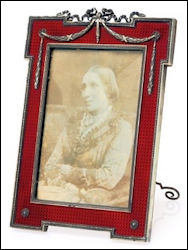
Fabergé Frame Sold with
Azur Enchères €45,500
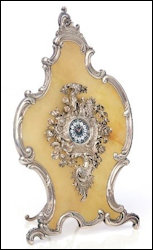
Fabergé Clock Sold with
Honfleur Enchères: €37,020

Fabergé Cufflinks Sold with
Thierry de Maigret: €21,896
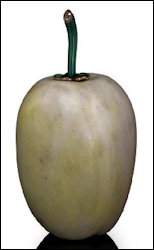
Fabergé Apple Sold with
Millon: €34,455

Silver Kovsh, 50th Anniversary Gift
(Courtesy Schmidt Kunstauktionen, Dresden)
- Sparke, Cynthia, and Hoff, DeeAnn: “Fabergé’s Monumental Kovshes with Bogatyr Themes” in: Fabergé Research Newsletter, Winter 2015.
- Hoff, DeeAnn: “From Bogatyrs to Boyars” in: Fabergé Research Newsletter, Winter 2016.



Fabergé Gum Pots from the Wigström Studio with Scratched Stock Numbers 12600-12602
(Courtesy Steve Kirsch, Fabergé Research Newsletter, Spring 2016 – 10th Anniversary Edition)
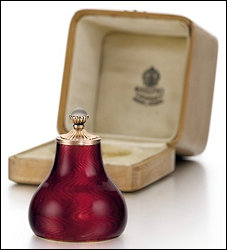
Red Gum Pot with the Sequential Stock
Number 12603 Sold at a 2019 Auction
(Sotheby’s London,
November 26, 2019, Lot 305)


A. Fabergé Bronze Cossacks, a Pair, Pustynnikov Chamber Cossack 1894 (sic)
(The Saleroom: The Home of Art & Antique Auction)
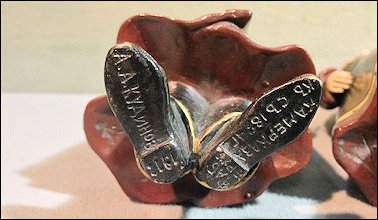

B. Cast-metal Inscriptions for Kamer Kazaks, Did Not Sell
(Courtesy Rowley’s Fine Art Auctioneers and Valuers)


C. Fabergé’s Hand-carved Inscriptions for Kudinov (left) and Pustynnikov (right), Created in 1912
(Courtesy GIA, p.135)

D. 1935 Original Newspaper Photograph of
the Pansy Egg by the Hammer Galleries, New York
(Source: Associated Press – McCanless Collection)

E. “Fabergé’s Famous Apple Blossom Egg
Celebrated on New Coin from Coin Invest
Trust”, CoinWeek, November 22, 2019.
Provenance of the 1899 Pansy Egg:
- April 18 (OS), 1899. Would have been presented to Marie Feodorovna, a gift from Nicholas II; cost 5,600 silver rubles. Housed in the Anichkov Palace
- September 16-20 (OS), 1917. One of forty or so eggs sent to the Armoury Palace of the Kremlin in Moscow by the Kerensky Provisional Government for safekeeping
- February-March 1922. Transferred to the Sovnarkom, the Council of People’s Commissars
- June 17, 1927. One of sixteen eggs returned by the Foreign Currency Fund of the Narkomfin (Finance Ministry) to the Armoury; given inventory no. 17539
- April 30, 1930. One of twelve eggs selected for export sale
- June 21, 1930. Transferred from the Armoury to the Antikvariat (Trade Department)
- 1930. One of ten Imperial eggs sold by the Antikvariat, Moscow, to Hammer Galleries, New York, for 7,500 rubles (ca. $3,750)
- March 9/10, 1935. Associated Press Photograph with Cut-line for A Treasure of the Romanoffs and the text “Workmanship Alone Cost $50,000 per Hammer Galleries, New York”
- November 1936. Advertised by Hammer Galleries, New York
- April 1943. Displayed in Hammer Galleries, New York
- 1947. First egg bought from Hammer Galleries by Matilda Geddings Gray, oil heiress, of Lake Charles and New Orleans, Louisiana. Given to her niece, Mrs. Matilda Gray Stream of New Orleans, Louisiana, as a first wedding anniversary present
A coin (E.) with the Apple Blosssom Egg image was issued in December 2019 to honor the 100th anniversary of the death of Carl Fabergé. For more details, “The Liechtenstein Fabergé Egg”, CoinsWeekly, December 19, 2019.
Videos:
- An Egg-stravaganza! Fabergé Eggs from the Royal Collection
- “Parmigiani Fleurier and the Yusupov Fabergé Egg of 1907” by Elizabeth Doerr, Quill & Pad, April 4, 2020
A reader inquired about a fold-out brochure with a Comparative Time Line created for the 1989 San Diego Museum of Art Fabergé: The Imperial Eggs exhibition during which 27 Fabergé eggs were united for the first and only time. The question, is there such a time line for all known Fabergé eggs – Tsar Imperial, Imperial, Kelch, and Other? Contact: Christel McCanless
(Checking exhibition status in advance is advised.)
- Baltimore, Maryland. Walters Art Museum
Forty-one Fabergé objects with description, conservation, exhibitions, provenance, inscription, and credit notes are presented on their website. - Cleveland, Ohio. Cleveland Museum of Art
Seventy-eight objects with descriptions and further details for the artist biography, inscriptions, citations, exhibition history, and related content are online.The Ingalls Library at the CMA has digitized its copy of the Catalogue of the Exhibition of Russian Art: 1 Belgrave Square, London S.W. 1, 4th June to 13th July, 1935. The first-ever western Fabergé exhibition was held at the stately mansion of Madame Koch de Gooreynd to benefit the Imperial Russian Red Cross. (Further details, McCanless, Fabergé and His Works: An Annotated Bibliography of the First Century of His Art, 1994)
- Copenhagen, Denmark, Amalienborg Palace – Now the Fabergé Chamber in the Amalienborg Museum Is Open.
“Visit our new, permanent treasury at The Amalienborg Museum! On display is Russian jewellery from the period 1860-1917, with a focus on the close ties between the Danish and Russian monarchies. A selection of the Danish Crown Jewels is also exhibited …”Ludmila and Paul Kulikovksy, great-grandson of Grand Duchess Olga Alexandrovna, in Romanov News, February 2020, No. 143, pp. 1-16, share photographs from the opening event.
- Houston, Texas. Houston Museum of Natural Science
Through the generosity of the Arthur and Dorothy McFerrin Collection Fabergé objects are on loan to other exhibitions, i.e., Hillwood Museum, Washington (DC), Museum of Russian Icons, Clinton (MA), and the Fabergé at Sea exhibition in May of 2021 at the Catalina Island Museum (CA), which then moves to the Houston Museum of Natural Science (TX), November 2021 – July 2022.A stunning tiara, the newest addition to the McFerrin collection, has been featured:
- on the HMNS website – “The Grand Duchess Tiara“
- Fabergé Tiaras and the Unveiling of an Acquisition by Christel Ludewig McCanless (USA) and Kristin Mills (USA) Fabergé Research Newsletter, Fall and Winter 2019.
- McFerrin-Bohner, Jennifer. “Bringing the House of Fabergé to Our House”, Naturally Curious publication by the Houston Museum of Science, Winter 2019, pp. 15-19.

Novgorod Merchant (Kupets)
(Photograph at the Houston Museum of
Natural Science, Christel McCanless)
Postcard of a Priest by Evgeny Sokolov,
Moscow Graphic Artist and Stage
Designer, 1904-1908
(Jewellery Art of the 19th and
Early 20th Centuries Symposium)
Christie’s Geneva, November 18, 1980, Lot 106
A Russian type hardstone figure by Fabergé when it first came on the auction market (Christie’s Geneva, November 18, 1980, Lot 106) was called a Novgorod Merchant (Kupets). The object is now part of the McFerrin Collection and has been renamed a Priest based on research presented in a video lecture at Hillwood Museum by Mikhail Ovchinnikov, Fabergé in the Age of Progress, and a symposium presentation, On the Role of Prints in the Design of Fabergé’s Works, at the 2018 International Academic Conference at the Fabergé Museum in St. Petersburg, pp. 73-79, and illustration no. 29.
The HMNS Blog does not appear to be active at the present time.
- on the HMNS website – “The Grand Duchess Tiara“
- London. Royal Collection of Queen Elizabeth II is only shown from time to time during temporary exhibitions. The collection’s website has 598 Fabergé objects indexed with these sub-categories: Description, people involved, physical properties groupings, place, and featured in a publication or venue. Each object is highlighted with one or more high quality photographs. A very helpful feature while researching an object is a link to the workmaster’s biographical sketch, for example Erik Kollin, from which the web user can then access the 18 objects in the Royal Collection made by the Kollin workshop.
- Moscow, Russia. Fersman Minerological Museum

A Reserve Regiment
Soldier, 1914
(Photograph by Tim Adams)
A scholarly treatise, “Fabergé Lapidary in the Fersman Mineralogical Museum Collection” by Marianna B. Chistyakova (New Data on Minerals, M. 2004, Vol. 39, pp. 120-136) complete with 30 colored illustrations of the Fabergé objects is an excellent introduction to the collection. The author writes, “In addition, in 1926, Peter Carl’s son Agafon Karlovich Fabergé, a good friend of Academician A.E. Fersman, then director of the Museum, donated the remaining cut stones after the firm was closed.”
- Moscow, Russia. Kremlin Armoury Museum (Non-museum website featuring the Fabergé eggs. In Russian) No further details available at press time.
- New York City. Metropolitan Museum of Art The loan of the Fabergé objects from the Matilda Geddings Gray Collection in New Orleans will end its New York City ten-year run in November 2021.
- Richmond, Virginia. Virginia Museum of Fine Arts
A very comprehensive website for the Lillian Thomas Pratt Collection, “the largest public collection of Fabergé and Russian decorative arts in an American museum. It includes about 200 objects by or attributed to the Fabergé firm, as well as ‘Old Russian’ – style works, such as silver and enamels, by Feodor Rückert and other masters”. Special features developed by the Freeman library staff under the leadership of Courtney Tkacz, archivist, and her colleagues, are the Pratt Archive with finding aids and collection viewers, 360° rotating videos of the Fabergé eggs in the collection, and a rare copy of the Coronation Album of Alexander III and Maria Feodorovna.If you have valuable Fabergé research material that you are interested in donating to the Freeman Library, please contact the staff at (804) 340-1495 or library@vmfa.museum.
- St. Petersburg, Russia. Fabergé Museum
The website for The Link of Times Fabergé Collection located in the renovated Shuvalov Palace by the Fontanka River presents a variety of ways to approach the uploaded data.For St. Petersburg history buffs, an English audio-guide with illustrations to the various rooms in the former Shuvalov Palace and an exhibition layout for its current use of the palace’s rooms are available.
For English-speaking readers, a Fabergé collection overview with these specifics,
- History of the Collection
- Collection Highlights
- Fabergé Museum Books
- Carl Fabergé and His Firm, or a virtual tour are inviting.
The archives of Henry C. Bainbridge, manager of the London branch (McCarthy, Kieran. Fabergé in London: The British Branch of the Imperial Russian Goldsmith, 2017), and the Forbes Magazine Collection archival collection have been deposited in the Fabergé Museum.
Researchers will find the 2014 Exhibit Index with some detail on the objects in the collection, and the latest in a series of printed Fabergé symposium presentation in Russian with English summaries of interest.
The Fabergé Museum in St. Petersburg, Russia, began sponsoring annual symposiums in 2014. Scholarly research summaries of the papers presented at these events have been published in the Fabergé Research Newsletter, Summer 2018, and in paperback format by the museum. Readers should be aware the paperback publication for a given year is published a year after the actual symposium. The study topic for the 2018 symposium was Jewellery Art of the 19th and Early 20th Centuries with the summary of the papers in Russian and English from the International Academic Conference published in the latter part of 2019.
- St. Petersburg, Russia. State Hermitage Museum
The Fabergé Collection is located in two Carl Fabergé Memorial Rooms. A third room of the General Staff Building houses a loan exhibition, Fabergé and the Great War. There is a virtual tour of the displays in these three rooms (#300-302).Our thanks to Viktoria Petrova of the Hermitage staff for sharing the above details on the Fabergé galleries. She added information about videos for the treasures in the museum:
- Vaduz, Treasure Chamber of the Liechtenstein National Museum has the Apple Blossom Egg by Fabergé on permanent display. A coin honoring this egg is available, for details see the Eggs section of this newsletter.
- Washington (DC). Hillwood, Estate, Museum & Gardens
What an adventure to explore this website! The Advanced Search link filled in with the word Fabergé (without or with an accent) brings up the Fabergé objects in the collection.“When I began collecting, I did it for the joy of it, and it was only as the collection grew and such great interest was evidenced by others that I came to the realization that the collection should belong to the country.” – Marjorie Merriweather PostExplore nearly 20,000 objects from Hillwood’s collection of Russian imperial art, French 18th century decorative art, and Marjorie Merriweather Post’s personal collection of apparel, jewelry, and accessories.
This Online Collection is a work in progress and many of the records here are not accompanied with an image or title and do not necessarily reflect complete or current knowledge about the objects. Research is ongoing. If you have information about any of these objects, please feel free to contact us at info@hillwoodmuseum.org
The sheer volume of recorded videos is one of the strong points of the Hillwood educational program. Mixed in are enough Youtube videos to entertain and educate any Fabergé enthusiast.Over the years two articles have appeared in the newsletter about a very unusual object in the Hillwood Collection – the Nuptial Crown (not Fabergé) Fall 10 | Summer and Fall 16 with an excerpt from this last issue:
“In 1952, Armi Kuusela was crowned the first ever ‘Miss Universe’. The 17 year-old ‘Miss Finland’ is shown in internet photographs wearing the Nuptial Crown at the pageant which took place in Long Beach, California. Ulla Tillander-Godenhielm contacted Armi Kuusela (age 81), who lives in California. Armi told Ulla, “the organizers had mentioned to her the crown had a Russian provenance, but no other information had been given to her.” Timothy Adams from California, discovered an article in the San Diego Union Tribune, September 5, 2014. His reaction to the find: “It is curious to see a nuptial crown used by the Imperial Family of Russia worn at a 1952 beauty pageant in California. Who loaned the crown to the pageant, and why? There must have been a connection between the owner at the time and the promoters of the pageant, but that has yet to be discovered.”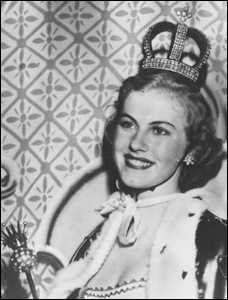
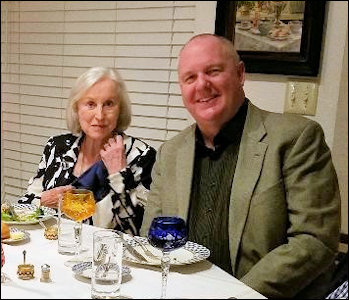 In January of 2020, Tim Adams had the distinct pleasure to be invited for a dinner event where he met “the charming, gracious lady with a truly kind and generous spirit”, who is allowing us to share these photographs. Armi Kuusela Williams still recalls with a sparkle in her voice the nuptial crown came in 1952 from a bank vault in Switzerland escorted with two guards, and had a Russian royal provenance. We love hearing first-hand history!
In January of 2020, Tim Adams had the distinct pleasure to be invited for a dinner event where he met “the charming, gracious lady with a truly kind and generous spirit”, who is allowing us to share these photographs. Armi Kuusela Williams still recalls with a sparkle in her voice the nuptial crown came in 1952 from a bank vault in Switzerland escorted with two guards, and had a Russian royal provenance. We love hearing first-hand history!A new illustrated biography, Marjorie Merriweather Post: The Life Behind the Luxury by Estella M. Chung is now available in the museum shop. As a visitor from Alabama to Hillwood in Washington (DC) I have enjoyed attending informative lectures, seeing the beautiful gardens, and always a shopping spree in the book section of the museum shop. I have never been disappointed!
(Exhibition dates change, checking in advance is advised.)
- September 14, 2019 – March 15, 2020 Hermitage Amsterdam in the Netherlands affiliated with the Russian Hermitage Museum in St. Petersburg. The Jewels! Glittering at the Russian Court exhibition has closed. The English catalog with the same title contains scholarly essays and presents many of the 300 dazzling jewels and more than 100 paintings, accessories, dresses and costumes which together give an impression of the wealth and extravagance of the Russian tsars and the St. Petersburg high society over the course of 200 years.
- November 19, 2019 – April 30, 2020 State Historical Museum, Moscow, Russia
Fabergé and the Court JewellersExhibition Review by Timothy Adams (USA)








Snapshots from Fabergé and the Court Jewellers Exhibition (Courtesy of the Author)
Final Image: International Guests Visiting with Galina Smorodinova (foreground) at the Opening Ceremony.Organized by the museum’s curator Galina Smorodinova, the venue featured pieces from the State Historical Museum Collection never before seen in public. It was my honor to be invited with Ulla Tillander-Godenhielm (Finland), Irina Polynina (Moscow), museum donors, political dignitaries, and historians for the opening reception. The center of the beautiful exhibition hall was reserved for the work of the Fabergé firm while along the walls of the room were objects by other prominent goldsmiths who catered to the Imperial Court.A large silver casket (image 3 above) made prior to 1899 by Julius Rappoport in St. Petersburg was of special interest to me. Engraved with images of eight historic military ships and chased with rococo motifs and dolphins, the casket was presented to Grand Duke Alexei Alexandrovich, General-Admiral of the Imperial Navy (1850-1908). Large presentation pieces in silver and precious stones given by merchant guilds, as well as jewelry and accessory objects, such as cigarette cases, bell pushes, and large sculptures of an elephant and a moose were on display. One of the more unusual Fabergé pieces is a large gold memorial chain of gold wreaths (image 5) given by friends and relatives of Grand Duke George Alexandrovich (1871-1899). The exhibition celebrated the revival of historic Russian design in Moscow and juxtaposes it to the courtly Western style of St. Petersburg. Over 300 pieces in this exhibition celebrated the renaissance of Russian gold work.
- Opening April 7, 2020 Museum of Russian Icons, Clinton, MA
Tradition & Opulence: Easter in Imperial Russia, an exhibition of nearly 200 objects, will recreate the splendor of Easter celebrations during the last days of the Tsars. No country is better known for its Easter eggs than Russia. From the jeweled creations of Fabergé to humble wood carvings, the nation’s greatest artists, icon painters, jewelers, and artisans have created imaginative egg designs in every medium for the most important of the Orthodox Christian feasts. Co-curators are Karen Kettering and Dmitry Gurevich. More…Also published by the museum is The Journal of Icon Studies, an online, peer-reviewed publication edited by Wendy Salmond, Chapman University, USA. An essay, “Fabergé’s Icons” by the same author appeared in the Fabergé Research Newsletter, Fall and Winter 2018.
- Opening May 2021 Catalina Island Museum, CA November 2021 – July 2022 Fabergé at Sea
Timothy Adams, curator of the Fabergé at Sea exhibition (May 2021 at the Catalina Island Museum (CA), and then at the Houston Museum of Natural Science (TX), November 2021 – July 2022) is searching for Fabergé objects made from materials found in the oceans of the world – salt water pearls, coral, and mother-of pearl. Loans of recent auction lots, or other examples are very much appreciated.You are invited to come see two unique Fabergé pieces which will be on loan from the U.S. Navy Silver Collection at the Annapolis Naval Academy in Maryland. Tim Adam’s research:

A. Fabergé Punch Bowl and Ladle
(Courtesy U.S. Naval Academy Museum, Annapolis, Maryland)The museum has two Fabergé objects made by the firm’s Moscow branch – a punch bowl and ladle (A.), and a kovsh (F.), a gift from Nicholas II. The punch bowl is a monumental piece of silver inlayed with a large emerald and red stones possibly rubies or tourmaline. Its rim and ball feet are chased with stylized patterns in the old Russian style. The two handles are topped with the Imperial double-headed eagles surmounted by the Imperial crown. Each eagle is set with a large oval red stone. The bowl is engraved with “USS Edward Fitzgerald Beale from his daughters”.
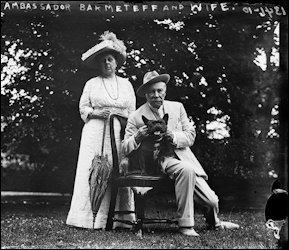
D. Russian Ambassador George Bakhmeteff
and His Wife Mary Beale
(Photograph: Wiki-Commons. LOC
Photo # ggbain.07163)The Destroyer (B. and E.) was named for Lieutenant Edward F. Beale (1822-1893), a naval hero, surveyor, American explorer and Ambassador to Austria-Hungary (C.), and launched on April 30, 1912. His daughter Mary (1852-1925) married George Bakhmeteff (1847-1928), Russian Ambassador to the United States (D.) Mary presented the punch bowl (A.) at the launching of the USS Beale, named for her father, on behalf of herself and her sister Emily (1854-1912), who was married to the publisher of the Washington Post. The destroyer was decommissioned in 1919, and then transferred to the Coast Guard in 1924.The second Fabergé piece is discussed by Cynthia Sparke and DeeAnn Hoff in “Fabergé’s Monumental Kovshes with Bogatyr Themes”. It is a large kovsh (F.) given to the USS Mayflower (G.) by Emperor Nicholas II for hosting the signing of the peace treaty between Russia and Japan after the Russo-Japanese War (1904-1905).
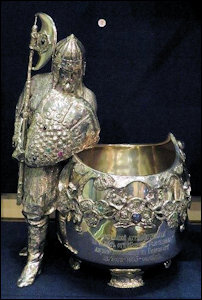
F. Fabergé Kovsh
(Courtesy U.S. Naval Academy
Museum, Annapolis, MD)The kovsh is also decorated in the old Russian style, in the form of a bogatyr, a medieval knight of Russian lore found in legends defending Rus (Old Russia of the 9th-12th centuries) from invaders. The knight leans against a bowl inlayed with Siberian stones and decorated with organic vine and floral motifs and has the inscription “To the hospitable Yacht Mayflower as a token from the Russian delegates to the peace conference at Portsmouth, August 1905”. The USS Mayflower was launched in 1896 as the Presidential Yacht and served five U.S. Presidents from Theodore Roosevelt (1858-1919) to Calvin Coolidge (1872-1933). Next it was used in the U.S. Coast Guard, in the Israeli Navy, and finally broken up in 1955. Fabergé objects connected to military ships and imperial yachts are a fascinating topic not yet explored in depth.
- Their 2019 Christmas catalog included a variety of Fabergé objects.
- Visiting the new store location includes learning about a pair of table lighters with a personality.
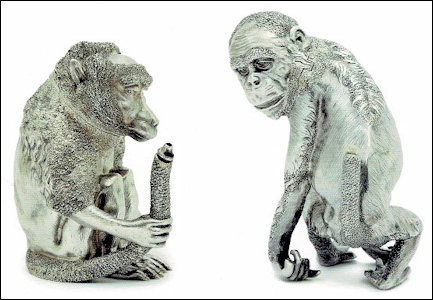
Fabergé Baboon and Monkey c. 1900
These simian table lighters, with wicks in their tails, illustrate Fabergé’s sense of humor.
The seated Baboon is anatomically correct but the Monkey is a curiosity. It most resembes
a chimpanzee – though chimps in life are tail-less – but the face also recalls 19th century
caricatures of Charles Darwin mocking the author of On the Origin of Species as an ape.
(A La Vieille Russie, New York)
- Burton, Ann Loynd. “The Story Behind the World’s Most Renowned Fabergé Dealer”, Galerie Magazine, March 6, 2020
Queen Victoria and The Romanovs: Sixty Years of Mutual Distrust by Coryne Hall is the latest of the author’s books on Russian history. It sketches in detail Queen Victoria’s interactions with the most important members of the Romanov family, and with their junior members. From the Fabergé enthusiast’s perspective, the book describes Fabergé gifts given to Queen Victoria, since her extended family occupied the dominant thrones of Europe, who were the major clients of Fabergé’s firms in London and in Russia. (Courtesy Katrina Warne)
Geoffrey Munn, Antiques Roadshow expert: “Finding Treasures Becomes Instinctive“. The Antiques Roadshow star says that he has developed a ‘hunter gatherer’s aptitude’ for finding jewelry after 30 years on the show … article published in The Telegraph, a British newspaper, February 23, 2020.
















